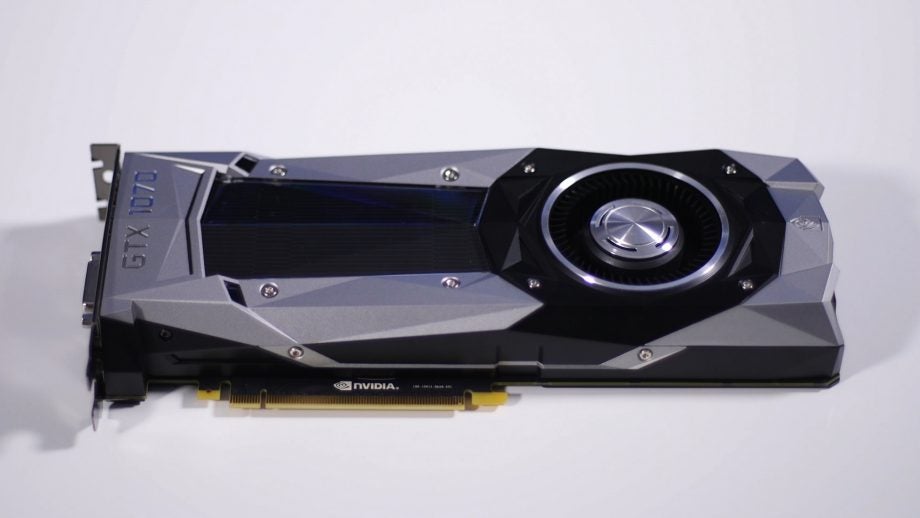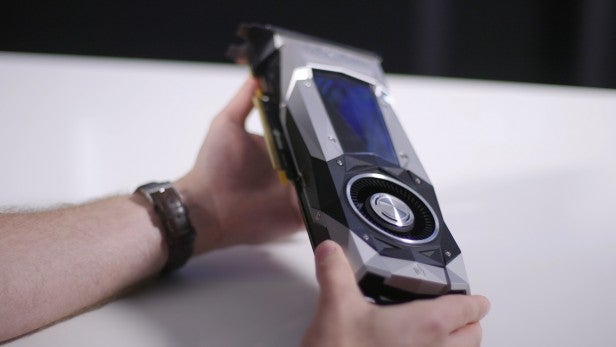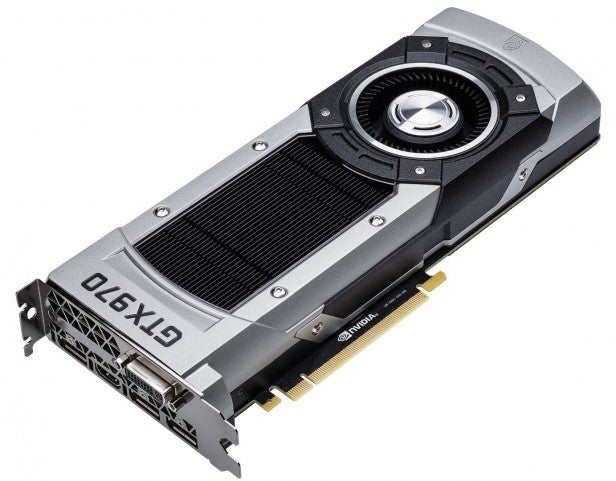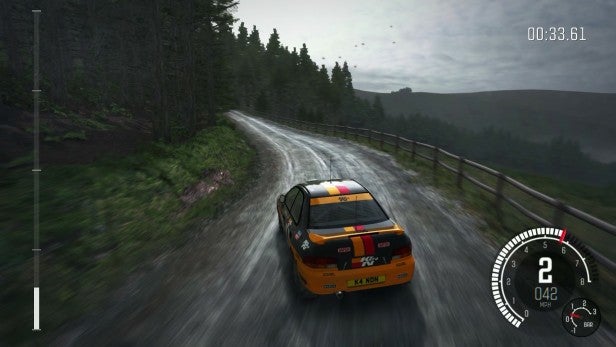Nvidia GeForce GTX 1070 vs GTX 970: What’s the difference?

Can Nvidia’s superb older GTX 970 graphics card take on the best of the new generation, the new GTX 1070?
Nvidia’s high-end cards always launch first and always attract the most attention, but canny gamers know that it’s worth looking a step down the range to find the best bang for their buck.
That’s where Nvidia tends to place GPUs that are powerful enough to handle most gaming tasks without costing upwards of £500.
Last year’s affordable barnstormer was the brilliant GeForce GTX 970, but now it’s been superceded by the GTX 1070. I’ve put them head to head to find out if the new card is the new king – or if the older GPU can still hold its own in terms of value for money.
Watch our Nvidia GeForce GTX 1070 video review
Nvidia GeForce GTX 1070 vs 970 – Technology
The GTX 1070 deploys the new Pascal architecture – the same silicon that underpinned the incredible GTX 1080.
The new architecture makes several big moves to improve performance and efficiency. One of the key changes involves the manufacturing process, which has shrunk from 28nm to 16nm. That move allows Nvidia to cram more transistors into the same amount of space, and each smaller transistor requires less electricity to work – so Nvidia can do more with less.
For a simple demonstration of this, just look at the bits of silicon that are used to build the GTX 1070 and GTX 970. The GTX 970 and its 28nm process used 5.2 billion transistors on a 398mm2 die. The GTX 1070 fits 7.2 billion transistors onto a 312mm2 die. It also allows the GTX 1070 to arrive with a peak power requirement of 150W – just five Watts more than the GTX 970 with all those extra transistors.
Related: The ultimate gaming PC building guide

The new Pascal architecture comes with a host of exciting new features, too. There’s “pre-emption”, which allows the card to pick and choose between graphics and computing workloads, and Lens Matched Shading, which better allocates resources by not rendering pixels that the user won’t see. Simultaneous multi-projection is a new feature that enables the GTX 1070 to render a scene from up to 16 different viewpoints, which is great for VR.
Most games won’t use these features right away, but they’ll prove useful in the future, and it’s one area where the GTX 1070 outpaces its predecessor.
The slimmed-down architecture also allows the GTX 1070’s core to beat the GTX 970, at least on paper. The GTX 1070’s stock speed of 1,506MHz is miles ahead of the older card’s 1,050MHz core, and the GTX 1070’s 8GB of GDDR5 rattles along at 8,000MHz – but the GTX 970’s 4GB allocation is reined in to 7,010MHz.
And then there are the stream processors. The GTX 970 is built around 1,664 CUDA cores, but the GTX 1070 deploys nearly 2,000.
It sounds like a convincing victory for the GTX 1070, and it’s no spoiler to say that the 1070 smashes its predecessor in benchmarks. But it’s not all down to raw speed: the GTX 970 now costs a penny under £200, while the GTX 1070 starts at £380 – and both of these cards will handle 1080p and 1440p gaming, which is where Nvidia envisions these GPUs sitting in the marketplace.
Related: Oculus Rift vs HTC Vive – Which VR headset is best?
Nvidia GeForce GTX 1070 vs GTX 970 – Performance
Our test bench represents a fairly standard enthusiast gaming PC, with the following components in use.
Motherboard: Asus Z170-Deluxe
- Processor: Intel Core i5-6600K (not overclocked)
- RAM: Corsair Vengeance 2666MHz, 16GB DDR4
- Cooler: Corsair H60 liquid cooler
- PSU: Corsair CX750M
- SSD: Samsung 850 EVO
- OS: Windows 10 Pro 64-bit
DIRT Rally, Ultra

Full HD – GTX 970: 97.3, GTX 1070: 134.7
1440p – GTX 970: 65.4, GTX 1070: 97.4
4K – GTX 970: 34.44, GTX 1070: 52.5
This fast-paced racing benchmark flings textures around with more rapidity than any other test game, but it’s still the easiest title in this test.
It’s no surprise that both GPUs handled DIRT’s 1080p benchmark with aplomb, although the gulf between older and newer cards was immediately obvious. The GTX 970’s average of 97.3fps is excellent, but the GTX 1070 was 38.44% quicker.
The new card extended its lead at 1440p. Its average of 97.4fps is great, and it’s more than 30frames ahead of the GTX 970’s 65.4fps result – a gap of 48.93%.
The ease of this benchmark meant that both GPUs handled its 4K test, but the widened gap highlighted the architectural differences between the two. The GTX 1070’s average of 52.5fps is good enough to ensure smooth play at 3,840 x 2,160, but the GTX 970’s 34.44fps result is barely over the 30fps barrier – and its sub-30fps minimum means it’ll be too jerky to play such a fast-paced game properly at this resolution.
Middle-earth: Shadow of Mordor, Ultra

Full HD – GTX 970: 85.4, GTX 1070: 131.3
1440p – GTX 970: 55.85, GTX 1070: 89.8
4K – GTX 970: 37.7, GTX 1070: 46.7
Middle-earth: Shadow of Mordor tests graphics cards by throwing around a huge variety of particle, weather and environmental effects during a relatively short benchmark run.
The GTX 1070 maintained its wide lead in the first Middle-earth test. Its 1080p average of 131.3fps is ample to secure smooth gameplay, and the GTX 970 fell back with a result of 85.4fps.
Nvidia’s new card continued to impress at higher resolutions. Its 1440p pace of 89.8fps is more than 30 frames ahead of the GTX 970, and the new card then scored 46.7fps at 4K.
The GTX 970 handled that high-resolution test with an average of 37.7fps, but that’s not quite enough to convince me that the game will run smoothly during frantic moments.
Hitman, Max settings

Full HD – GTX 970: 59 GTX 1070: 81.7
1440p – GTX 970: 45.4 GTX 1070: 69.8
4K – GTX 970: 25.08 GTX 1070: 29.8
Hitman is one of the toughest games in my suite of test titles, thanks to its reliance on NPCs, objects and complex lighting, and I’ve set it to run at its peak settings.
That said, both cards blitzed the 1080p benchmark. The GTX 970’s 59fps average is only a single frame short of the 60fps target for butter-smooth playback, and the GTX 1070 romped through with an easy victory and an average of 81.7fps.
The gap between the two cards was maintained at 1440p. The older card’s 45.4fps result is playable, but the newer Pascal GPU eased through with an average of 69.8fps.
Hitman’s 4K test is the first time I’ve been able to see the limits of both of these cards. The GTX 970’s average of 25.08fps is not good enough for smooth gameplay, but the GTX 1070 could only manage 29.8fps. That’s better, but it’s still not able to beat the 30fps barrier, and it means that gameplay still won’t be smooth using Nvidia’s newer card. After all, there’s a reason why Nvidia recommends the GTX 1080 for 4K gaming.
Rise of the Tomb Raider

Full HD – GTX 970: 60, GTX 1070: 97.9
1440p – GTX 970: 36.7, GTX 1070: 65.6
4K – GTX 970: 19.86, GTX 1070: 34
Few games have weather effects as intensive as this wind- and rain-soaked platformer, and every option in this test has been tuned to its maximum level.
At 1080p the GTX 970 nailed the 60fps target exactly, but the GTX 1070 clapped back with an average that was nearly 40fps better – a gap of 63.17%.
The vast difference between the two architectures was highlighted at 1440p, too. Here the GTX 970 averaged 36.7fps, which isn’t far above the bare minimum of 30fps for playable gameplay. The GTX 1070 answered with an easy 65.6fps average.
There are few better demonstrations of the gulf between these two cards than Tomb Raider’s 4K benchmark. The GTX 1070’s average of 34fps is good, although a sub-30fps minimum means it’ll be occasionally juddery at 4K. The GTX 970, though, could only manage an average of 19.86fps – that’s unplayable unless the graphics settings are dialled right back.
Performance Conclusions
There’s no doubting the huge gulf between the GTX 970 and GTX 1070 in games tests. There’s a sizeable gap between the cards in 1080p benchmarks, and in many games the size of the gap actually increased when I upped the resolution.
The higher framerates saw the GTX 1070 produce smoother gameplay across the board, and it was playable in more 4K titles than its predecessor.
That’s good, but the GTX 1070 still has caveats. The extra power means that many games will work at 4K and with VR headsets, but the GTX 1080 has far more headroom and remains a better future-proofed option.
The GTX 970, meanwhile, is no 4K card – but it’s still an extremely solid performer at 1080p and 1440p.
Other Things to Consider
Don’t spend extra cash on one of Nvidia’s “Founders Edition” versions of the GTX 1070 – these have a solid metal heatsink, but offer nothing for the higher price aside from the kudos of having the launch version of the card.
Instead, look to Nvidia’s board partners. Many cards are already available with multi-fanned heatsinks, and some firms are even producing mini-ITX models for small-form-factor rigs, and water-cooled cards for high-end performance and overclocking.
Most versions of the GTX 1070 come pre-overclocked, too, with modest overclocks if you spend less than £400 and boosts to beyond 1,650MHz if you’re willing to pay more than £400.
The GTX 970 is available with similar variety. Sub-£200 cards are routinely overclocked, and there are a huge number of options when it comes to heatsink designs, from tiny cards to reference designs and high-end beasts with three fans.
Related: Best Graphics Cards
Verdict
The GTX 970 was one of the previous generation’s biggest success stories, but it’s made to look ordinary by the GTX 1070.
That said, it’s not all bad news for the older card. The GTX 970 still has enough ability to handle virtually any game at 1080p and 1440p, and it’s far cheaper than the newer GPU. You miss out on features and future-proofing, but it’s worth examination if you’re on a tight budget. If you’ve found a cut-price GTX 970, you’re in for a treat.
The GTX 1070, though, is a smasher. It’s more expensive, sure, but it has that new Pascal architecture, and it’s significantly quicker. That speed enables smoother play in current games, and it also opens up some 4K and VR options – and it’s ready for whatever comes next, too.


